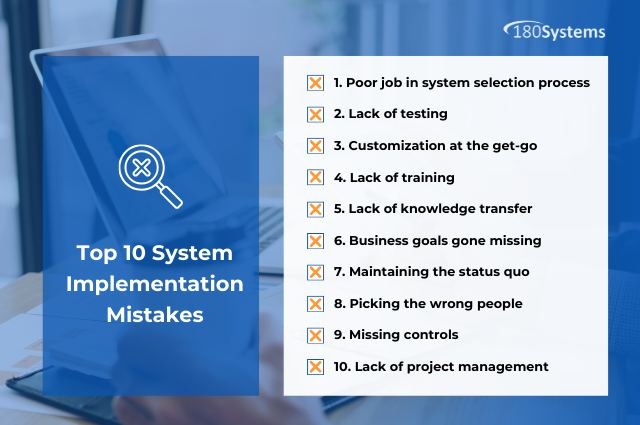Top 10 implementation mistakes
New ERP implementation process is riddled with pitfalls. But don’t expect implementation to be any easier. Let’s count down to the number one reason for ERP implementation failure and examine how you and your team can overcome these 10 pitfalls. This article was published in the CAmagazine in February 2008.

1. Poor job in system selection process
Companies that do a poor job at the selection stage whether in defining their scope, choosing the right product or gaining buy-in will find their mistakes come back to haunt them.
2. Lack of testing
If you haven’t properly tested the system, the go-live process could turn into go-nowhere. A representative set of transactions or a prototype should be processed through the entire system before you even attempt to go live. Many setup options exist in most systems and it may take a number of iterations before you get it right.
3. Customization at the get-go
For some systems, it’s no problem to add user-defined fields, change screens and reports, but it’s a risky business to add subroutines or programs to change processes (e.g., consolidation) not found in the new system
4. Lack of training
You should have subject matter experts for each area who know the system cold. They should have undergone formal training and worked with the prototype. The prototype not only ensures the system works properly but also offers the ideal way for people to learn by doing.
5. Lack of knowledge transfer
External people can justify higher fees by not sharing their knowledge and being called upon more frequently to solve problems. Internal staff may think their knowledge is their source of power.
6. Business goals gone missing
Some organizations have worked hard to create a business case for their new system, but as soon as the system is purchased, the business case gathers dust. The business case should have identified the benefits of the new system in terms of key performance indicators. The KPIs should act as a beacon for everyone involved in the implementation. When the KPI goals have been reached, it’s time to break out the champagne.
7. Maintaining the status quo
If you simply replicate the current business process in the new system, you will miss the best business process improvement opportunity you will ever have. And you might end up with large customization bills on your hands to change the new system to mirror the old one.
8. Picking the wrong people
You need highly motivated and knowledgeable people, and you need to make allowance for the time they will spend on the project. As mentioned in last month’s article, at least one champion should be assigned to act as a dedicated resource during implementation. Subject matter experts will need to allocate about 25% of their time during the implementation. Some organizations shoot for go-live dates to coincide with the beginning of a new fiscal year, but they shoot themselves in the foot instead. There is no technical or business reason to start at the beginning of the year.
9. Missing controls
Don’t assume internal controls are built into a new system. Automated controls might not be effective or sufficient. Some controls will inevitably be manual. Designing and testing of controls should occur before the go-live date. There should be at least one CA on the implementation team who knows about completeness, accuracy, validity and security.
10. Lack of project management
Good project managers can have the right aptitude and attitude as well as their peers’ respect, and still mess up badly. Project managers are often middle-management types working their way up the ladder. They are eager to please everyone, which is just not possible given their job description. They will often receive requests to add functionality (scope) and some of these requested changes will be good ones. But the project manager needs to stand firm and not allow changes in scope.